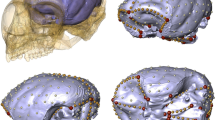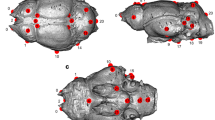Abstract
The taxonomic position ofTarsius has been a topic of some debate. Recent molecular and anatomical studies have shoen that tarsiers share a number of derived traits with Anthropoids. These include aspects of their reporductive biology and aspects of their olfactory and visual systems. It has, therefore, been suggested that, despite a number of convergences with strepsirhine primates, tarsiers should be classified with the Anthropoid primates. We use comparative analyses of relative primate brain part volumes to determine whetherTarsius should be classified as a Haplorhine. We show that, for each of seven brain components whose relative size discriminates unequivocally between Strepsirhines and Haplorhines, the tarsiers fall in the Haplorhine distribution. These results confirm their classification with the Haplorhines.
Similar content being viewed by others
References
Barton, R. A.;Dunbar, R. I. M. 1997. The evolution of the social brain. In:Machiavellian Intelligence, Vol. 2,Byrne,R.;Whiten,A. (eds.) Cambridge Univ. Press, Cambridge, pp. 240–263.
Dene, H. T.;Goodman, M.;Prychodko, W. 1976. Immunodiffusion evidence on the phylogeny of the primates. In:Molecular Anthropology,Goodman,M.;Tashian,R. E.;Tashian,J. H. (eds.), Plenum Press, New York, pp. 171–195.
Dunbar, R. I. M. 1992. Neocortex size as a constraint on group size in primates.J. Human Evol., 20: 469–493.
Dunbar, R. I. M. in press. The social brain hypothesis.Evol. Anthropology.
Estes, R. D. 1972. The role of the vomeronasal organ in mammalian, reproduction.Mammalia, 36: 315–341.
Jolly, A. 1966. Lemur social behaviour and primate intelligence.Science, 153: 501–506.
MacPhee, R. D. E.;Cartmill, M. 1986. Basicranial structures and primate systematics. In:Comparative Primate Biology, Vol. 1: Systematics, Evolution and Anatomy,Swindler,D. R.;Erwin,J. (eds.), Alan R. Liss, New York, pp. 219–275.
Martin, R. D. 1990.Primate Origins and Evolution, Chapman & Hall, London.
Pocock, R. J. 1918. On the external characters of the lemurs and ofTarsius. Proc. Zool. Soc. Lond. (1918), pp. 19–53.
Sokal, R. R.;Rohlf, F. J. 1969.Biometry, W. H. Freeman, San Francisco.
Sawaguchi, T. 1988. Correlations of cerebral indices for “extra” cortical parts and ecological variables in primates.Brain Behav. Evol., 32: 129–140.
Starck, D. 1975. The development of the chondrocranium in primates. In:Phylogeny of the Primates,Luckett,W. P.;Szalay,F. S. (eds.), Plenum Press, New York, pp. 127–155.
Stephan, H. 1984. Morphology of the brain in tarsiers. In:The Biology of Tarsius,Niemitz, C. (ed.), Gustav Fischer, Stuttgart, pp. 319–344.
Stephan, H.;Baron, G.;Frahm, H. 1988. Comparative size of brains and brain components. In:Comparative Primate Biology, Vol. 4: Neurosciences,Steklis,H. D.;Erwin,J. (eds.), Alan Liss, New York, pp. 1–38.
Stephan, H.;Frahm, H.;Baron, G. 1981. New and revised data on volumes of brain structures in insectivores and primates.Folia Primatol. 35: 1–29.
Author information
Authors and Affiliations
About this article
Cite this article
Joffe, T.H., Dunbar, R.I.M. Tarsier brain component composition and its implications for systematics. Primates 39, 211–216 (1998). https://doi.org/10.1007/BF02557732
Received:
Accepted:
Issue Date:
DOI: https://doi.org/10.1007/BF02557732




